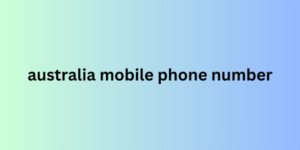According to Sprout Social, here are the best days to post on each platform:
Posted: Wed Dec 11, 2024 6:07 am
Under that approach, you simply drag an X into each category (target audience, content structure, and content medium) depending on your needs, and then you develop australia phone numberas many content ideas as possible with that target audience, content structure, and content medium in mind. Include the name of the person assigned to each article once, and you've already chosen what content to publish.
Content brainstorming keys are a great strategy because they help you visualize potential content ideas. When you run out of ideas, you can drag the X to another location and change your focus.

4. Set your publishing schedule.
Once you have a content idea, set a publishing schedule. Find the best time to post content. According to your school schedule , Tuesday is best for posting on your blog. If your content goals include social sharing, each social media platform will have its own optimal publishing times.
Facebook : Wednesday
Instagram: Wednesday
Twitter: Wednesday and Friday
LinkedIn: Wednesday and Thursday
Plan your publishing schedule based on that information, and incorporate it into your content calendar. Once you create a schedule, stick to it—you don't want to overhaul your entire publishing strategy just because you missed a deadline.
5. Check your results.
Once you have everything in your content calendar, it’s time to consider whether you’re achieving the content marketing goals you set out to achieve in the beginning.
If your KPI is X number of page views, are you achieving it? If not, by how much are you missing it?
Try to see how each content structure performs, too. Are infographics getting the views they need? If they're performing better than your blog posts, you may want to prioritize them in your next content calendar, assuming you have the same goal of increasing page views. Are long-form content getting more views than short-form content? Then incorporate more of those next time.
You need to check if your content marketing strategy is working so you know what content is engaging and what isn’t. So the next time you create a new calendar, you’ll know what content to include and exclude to achieve your content marketing goals.
Conclusion
A content calendar is essential to the success of your content marketing strategy. It can help you plan your content marketing activities. It can also help ensure collaboration among your team members.
To reap these benefits, you need to create a data-driven content calendar. You need to strategize around your target audience and KPIs. A purpose-built content calendar just won’t cut it.
Just follow the tips I’ve shared with you in this article. Once you have a data-driven content calendar, make sure you stick to it. The result? Your content marketing strategy will be a success, and your brand will achieve its business goals and beat the competition.
Of Bio Users
Hx1XYHaJu0ESyVfl2PDvGgNcz-_rAaT7-PdRYRrtWmIptPWFsLGVfKDd71kvJEWAy3-ZAxU_1j-pjSuYr9yN3u1P8pzdYgkSD_I1AoQKsuX9M7S9HYydiklH9SL4kcUBfCN8gwlF
Nicholas Rubright is a communications specialist for Writers, an AI writing assistant designed for teams. Nicholas has worked on developing content marketing strategies for brands like Webex, Havenly, and Fictiv.
Guest Author
Content brainstorming keys are a great strategy because they help you visualize potential content ideas. When you run out of ideas, you can drag the X to another location and change your focus.

4. Set your publishing schedule.
Once you have a content idea, set a publishing schedule. Find the best time to post content. According to your school schedule , Tuesday is best for posting on your blog. If your content goals include social sharing, each social media platform will have its own optimal publishing times.
Facebook : Wednesday
Instagram: Wednesday
Twitter: Wednesday and Friday
LinkedIn: Wednesday and Thursday
Plan your publishing schedule based on that information, and incorporate it into your content calendar. Once you create a schedule, stick to it—you don't want to overhaul your entire publishing strategy just because you missed a deadline.
5. Check your results.
Once you have everything in your content calendar, it’s time to consider whether you’re achieving the content marketing goals you set out to achieve in the beginning.
If your KPI is X number of page views, are you achieving it? If not, by how much are you missing it?
Try to see how each content structure performs, too. Are infographics getting the views they need? If they're performing better than your blog posts, you may want to prioritize them in your next content calendar, assuming you have the same goal of increasing page views. Are long-form content getting more views than short-form content? Then incorporate more of those next time.
You need to check if your content marketing strategy is working so you know what content is engaging and what isn’t. So the next time you create a new calendar, you’ll know what content to include and exclude to achieve your content marketing goals.
Conclusion
A content calendar is essential to the success of your content marketing strategy. It can help you plan your content marketing activities. It can also help ensure collaboration among your team members.
To reap these benefits, you need to create a data-driven content calendar. You need to strategize around your target audience and KPIs. A purpose-built content calendar just won’t cut it.
Just follow the tips I’ve shared with you in this article. Once you have a data-driven content calendar, make sure you stick to it. The result? Your content marketing strategy will be a success, and your brand will achieve its business goals and beat the competition.
Of Bio Users
Hx1XYHaJu0ESyVfl2PDvGgNcz-_rAaT7-PdRYRrtWmIptPWFsLGVfKDd71kvJEWAy3-ZAxU_1j-pjSuYr9yN3u1P8pzdYgkSD_I1AoQKsuX9M7S9HYydiklH9SL4kcUBfCN8gwlF
Nicholas Rubright is a communications specialist for Writers, an AI writing assistant designed for teams. Nicholas has worked on developing content marketing strategies for brands like Webex, Havenly, and Fictiv.
Guest Author